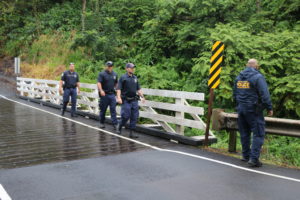DLNR Warns of Poison Use in Rivers to Catch Prawns
The DLNR’s Division of Conservation and Resource Enforcement (DOCARE) is advising people to know the source of any Tahitian prawns—also known as giant freshwater shrimp—they plan to eat.
Recent investigations by DOCARE officers have confirmed at least two cases of mass killings in East Hawai‘i streams caused by poisons for garden and household pests. The poisons are being used to kill and harvest Tahitian prawns and as a result, killing off all wildlife in the surrounding waters.
One case was confirmed last October in Onomea Stream cascading through Hawai‘i Tropical Botanical Gardens in North Hilo. Officers and garden staff believe someone illegally entered the property after hours and emptied an entire jug of Bug B Gon insect killer into the water.
“We found an empty bottle of the insecticide on the stream bank and found that there were not only no Tahitian prawns in the stream, but it looks like the poison killed everything,” said Officer Edwin Shishido, who investigated the case. “This was almost eight months ago and now finally with winter rains some life appears to be slowly coming back.”
Last fall, officers also encountered a group of men hauling 50-pound bags of prawns out of a stream farther north of Onomea. Officers believe poison was also being used in this location to kill and collect the prawns.
Though it is legal to catch prawns in Hawai‘i waterways, introducing any type of poison, insecticide, or rodenticide into streams or rivers is both a federal and state offense. It can also make unsuspecting people ill who eat prawns caught in this manner.
“We heard some people got sick after eating prawns killed in Onomea Stream,” said Shishido. “We also believe that the people doing this sometimes set up alongside roadways to advertise and sell prawns caught in this manner. It’s really important that buyers beware and know for certain where and how the prawns they’re buying were caught.”

DOCARE Officers investigate streams in North Hilo following confirmed cases of poison use to kill and harvest freshwater prawns. PC: DLNR.
In another incident last week, a private landowner contacted DOCARE to report a man trespassing on the owner’s property near a stream where poison was believed to have been used. Officers questioned the man but lacked enough evidence to charge him.
In response to these recent incidents, DOCARE has called on the help of inspectors from the Hawai‘i Department of Agriculture (HDOA) to survey stream conditions in Hawai‘i County. A large group of Hilo-based DOCARE officers recently joined an HDOA inspection team to tour more than half a dozen streams flowing from the east slope of Maunakea. Agriculture inspectors took samples to determine baseline water quality and determine if any poison may have been used in the area.
“With probably a hundred or so streams in East Hawai‘i, we obviously can’t be everywhere all the time,” Shishido said, “and this is why we need people’s help in immediately reporting suspicious activity along or in our streams and rivers.”
To report suspicious or illegal activity happening near or in any stream, call the statewide DOCARE hotline at (808) 643-DLNR or download the free DLNR tip application on any mobile device.












